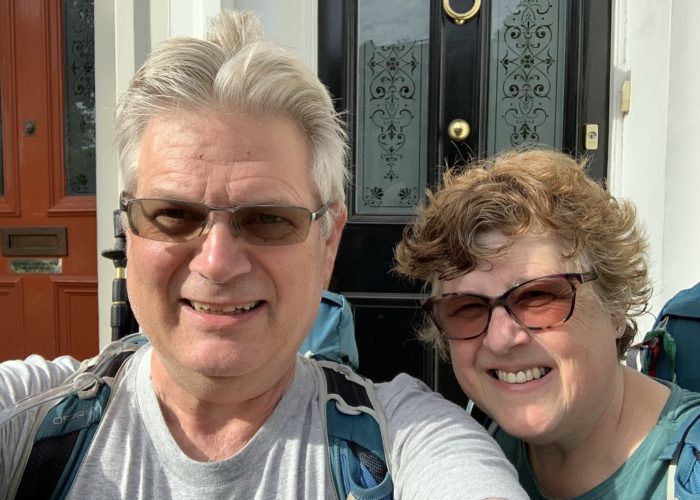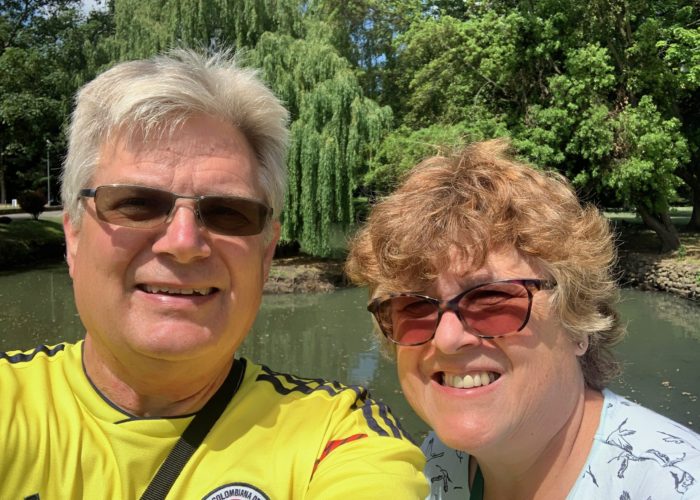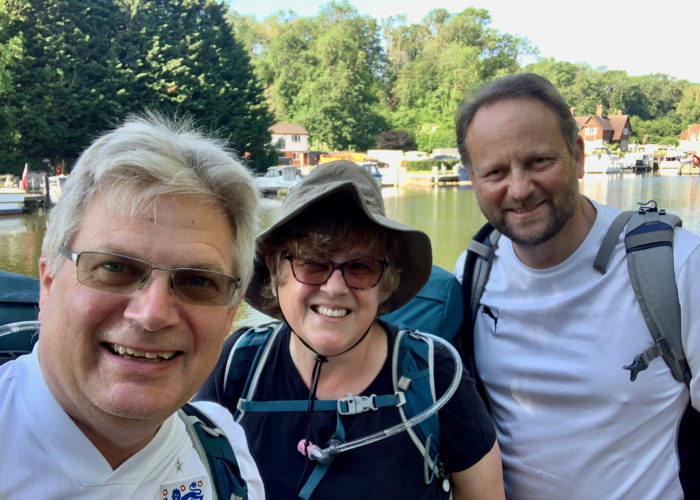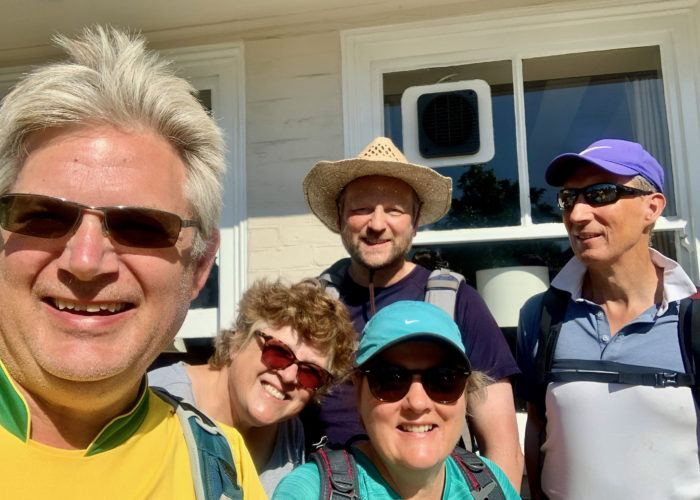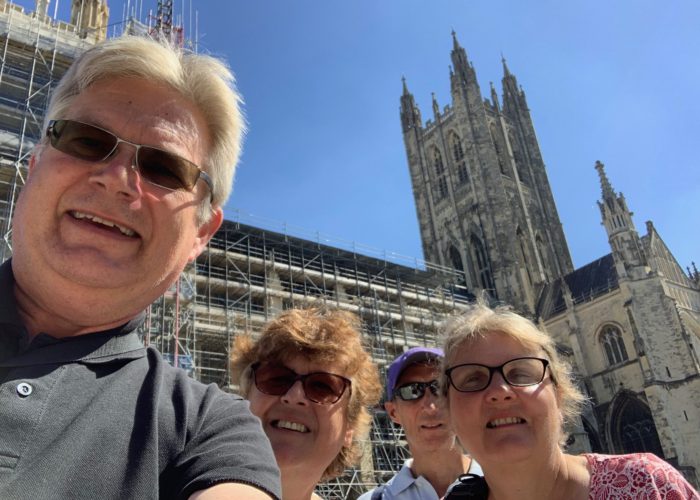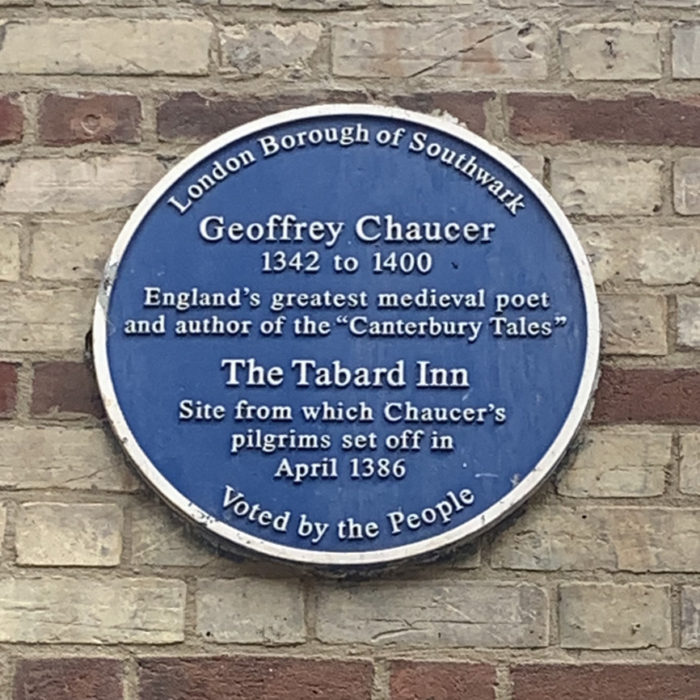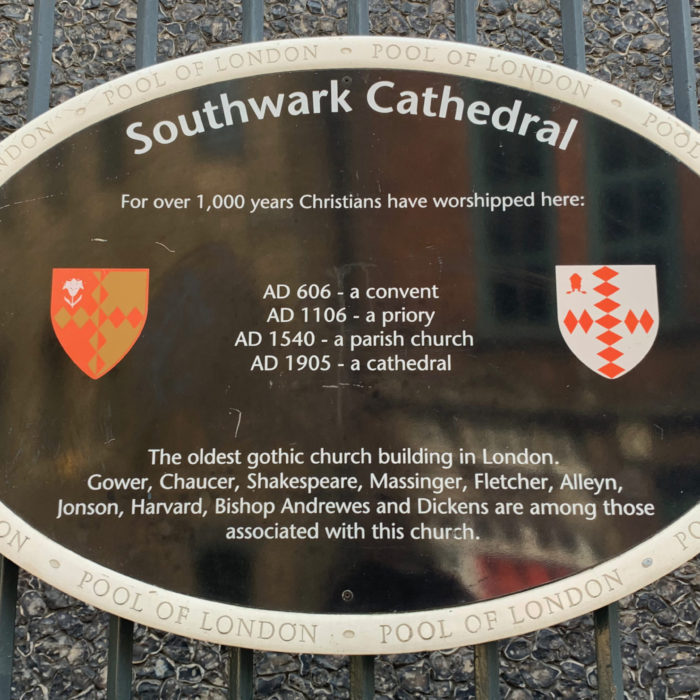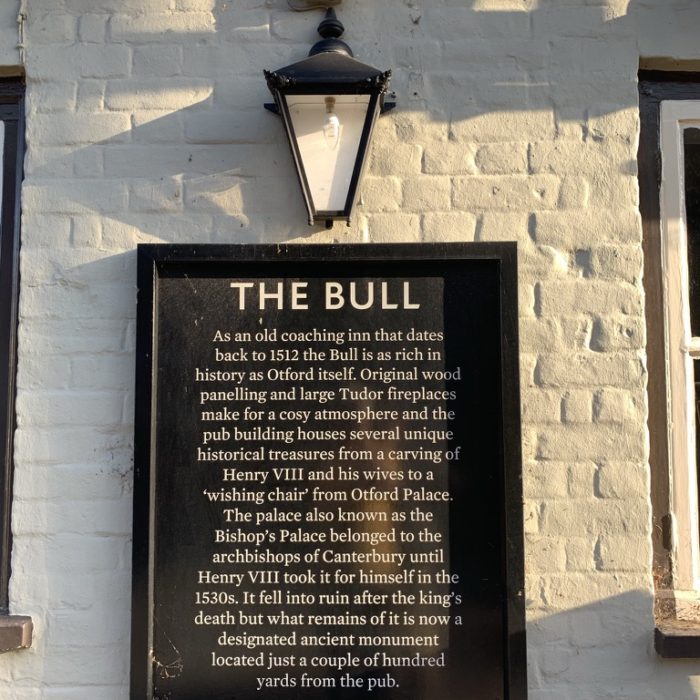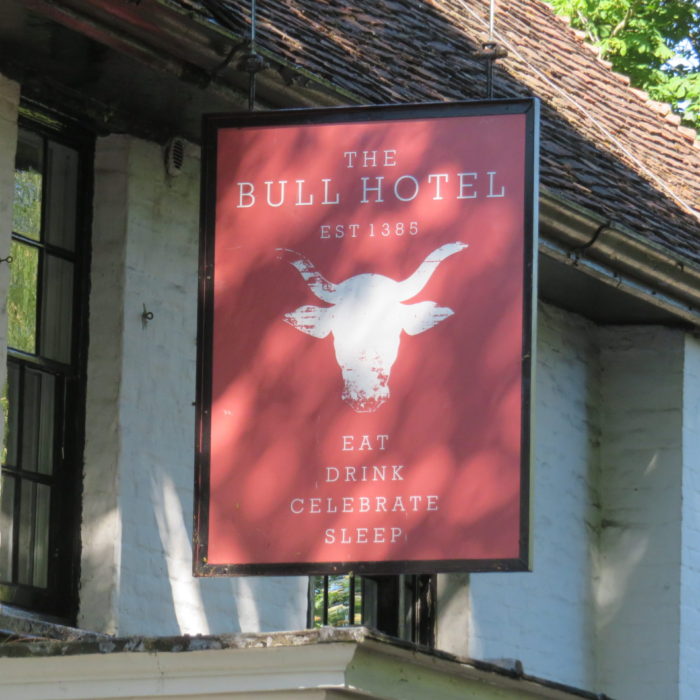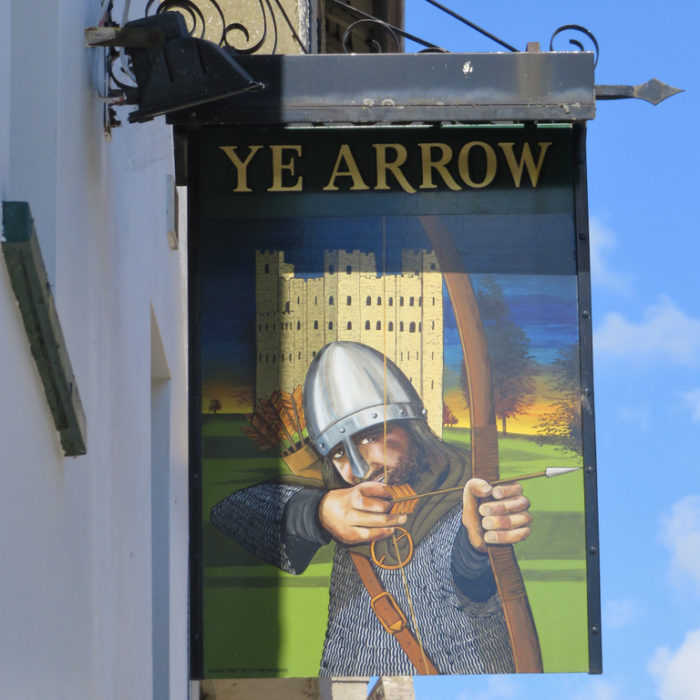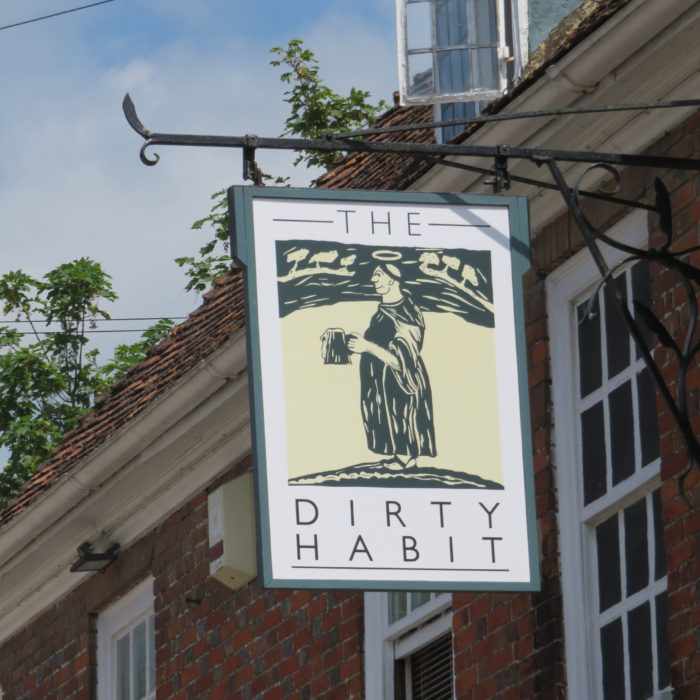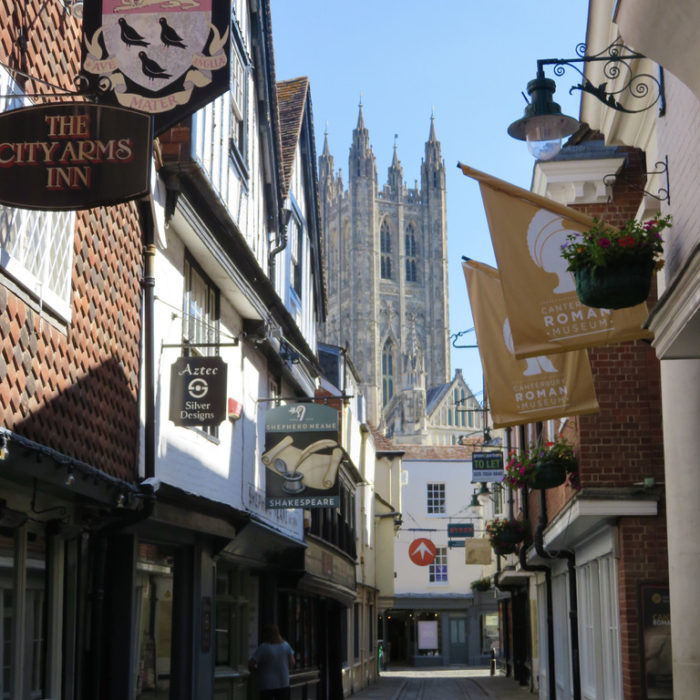In these restricted times of closed frontiers and chaotic management of the pandemic in most countries we made the decision to stay in the UK, but in keeping with our principles that the journey is as important as the destination, in June 2021 we decided to follow the Becket Pilgrimage Route on foot from Southwark Cathedral in London to Canterbury Cathedral in Kent. This is a route celebrated in Chaucer’s Canterbury Tales and historically has been one of the most important pilgrimage routes in England, despite the best efforts of one of England’s worst Kings, Henry VIII, to eradicate it from living memory.
Carrying out a pilgrimage is often on bucket lists of things to do and visit in ones life time, but in many ways it is much more than simply being something on a tick list of things to do. Any pilgrimage is by its nature a spiritual journey and, for me, with the recent loss of both my parents, gives you time to gather my thoughts and simply escape from the worries of the world, the pandemic, the UK government and the sycophantic UK media.
Becket Way to Canterbury is easily manageable in just over a week depending on how long you want to stay in places on route and the countryside is particularly beautiful. In addition, throughout the journey we visited many churches and in all were made to feel incredibly welcome and finally at the finish in Canterbury were welcomed as bona fide pilgrims.
Any journey in these COVID times has to be well organised as the ability to simply rock up in a destination without pre-booked accommodation is very difficult. This unfortunately takes away some of the spontaneity of any journey, but with Booking.com and hotel chains we were able to create a workable journey.
Day 1 Highbury to Bexleyheath via Southwark Cathedral – 32kms
We wanted to get out of London as fast as possible so that we could enjoy the countryside and get away from the hustle and bustle of the built up area and its pollution, so aimed on day 1 to get as near to the outskirts of London as possible. In addition with the aim of completing the whole journey on foot we decided to walk the seven kilometres from our house to Southwark Cathedral, the official start point of the Pilgrimage Route.
The journey on foot to London Bridge through the City is one that we have done many times and starting at 8:30 am in good weather, it was pleasing to see that activity was beginning to recover in the City. The views from London Bridge are always some of the best in London and make an excellent place to start the pilgrimage.
Southwark Cathedral dates back to 1086 but much of the building today was largely rebuilt by the Victorians. It is a large airy space with some stained glass windows and is a great place for peaceful contemplation surrounded by busy streets and markets. It also where you collect your first stamp on the Pilgrims Passport that you use to mark your journey. However, in COVID Times, many churches and other key places on the pilgrimage are not fully open so collecting passport stamps is somewhat patchy.
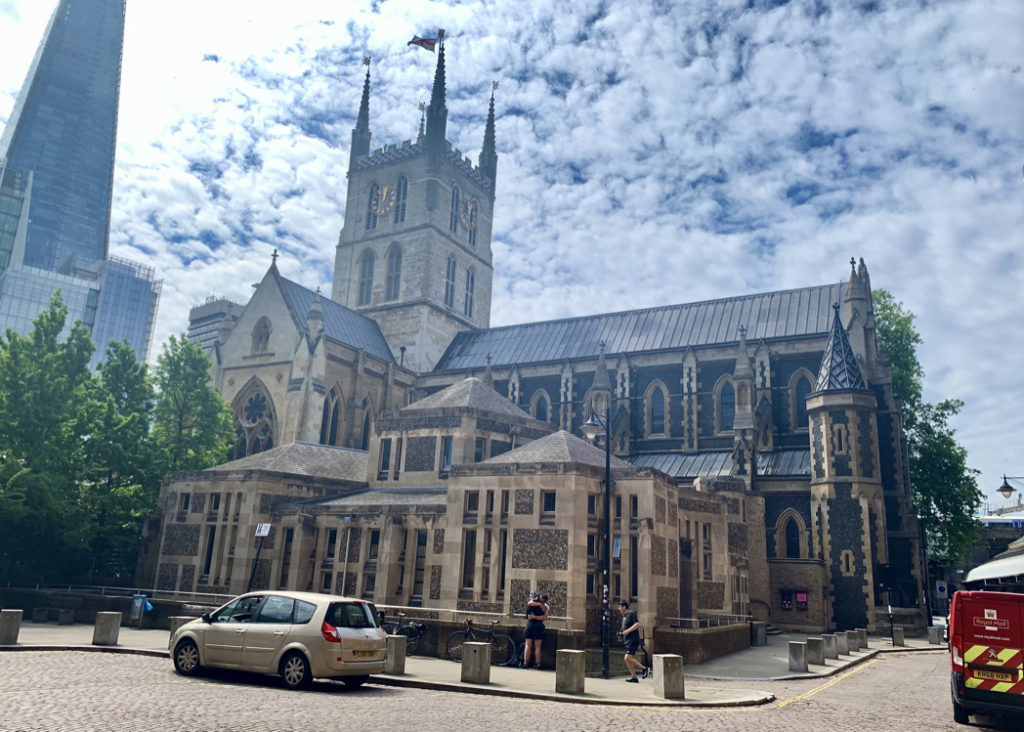
The area around Southwark Cathedral features prominently in the novels of Charles Dickens, especially the debtors prison at Marshalsea that is central to Little Dorrit, and also is the site of the Tabard Inn where Chaucer’s pilgrims set off from in the fourteenth century. While today not much of the original buildings remain, the streets contain many plaques and references to them.
From Southwark the route takes you through a number of post war housing estates and onto The Old Kent Road, famous for being the cheapest property on the Monopoly Board. The Old Kent Road, as it has done over many years, is an area where new migrants to London first start off their new lives in London. Today the top part of the road has many shops and supporting the Latino community, especially that from the Dominican Republic. As you progress down The Old Kent Road the communities change, especially with the Vietnamese turning some of the old pubs into restaurants. Just beyond New Cross the area becomes much more hipster with lots of coffee shops with young people using them as space to work on their computers.
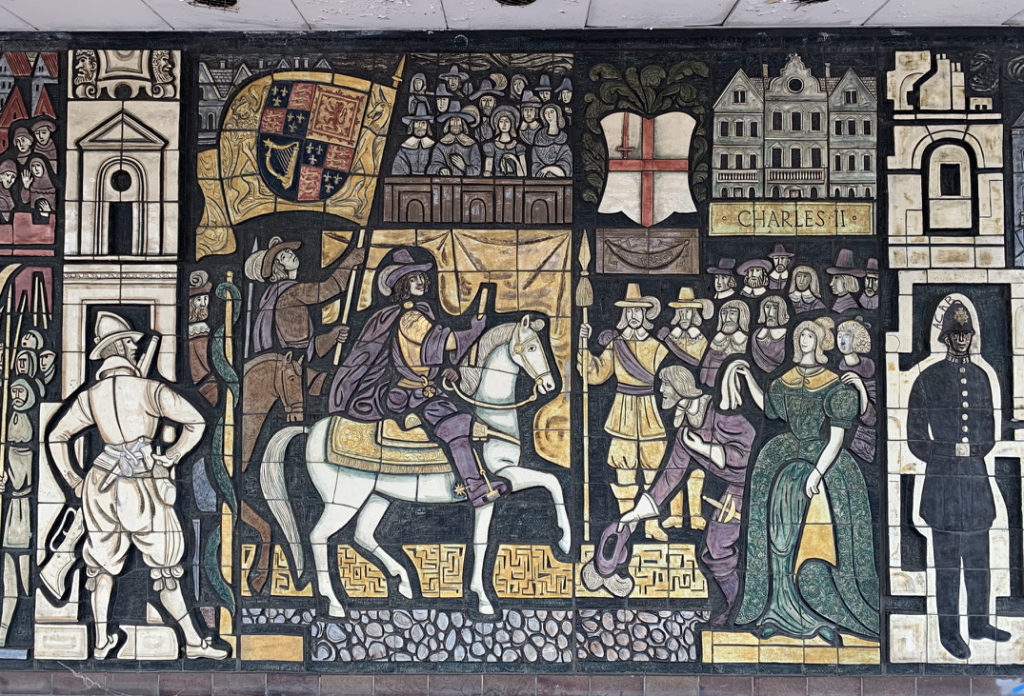
Beyond Lewisham the route takes you to Blackheath with its multi-million pound homes, open space and also panoramic views back to London. Of course Blackheath was not always so salubrious as it was the original meeting place for Wat Tyler’s Peasant Revolt in 1385 and also one of the burial sites for the Black Death in the 14th Century. All along the route there are many important historical places, especially with the Middle Ages.
From Blackheath our route took us to Shooters Hill, famous for being a haunt of highwaymen in the Middle Ages and being one of the highest places in London and onto Bexleyheath. Bexleyheath is one of those small villages that was absorbed into London in its great expansion in the early 20th Century, and today is a relatively prosperous suburb of London. In Bexleyheath after a long day we stayed in the local Premier Inn, which is well positioned for the bars and restaurants in the main shopping street.
Day 2 Bexleyheath to Kemsing – 18 kms
After a long first day, on day 2 our target was to get down to near Sevenoaks, where the Becket Route joins the Winchester route. This was probably over ambitious and while it was great to do most of London in one day, it may have been better to end day 2 somewhere in the Darent Valley, however in most of the villages there have very few places to stay.
The road out of Bexleyheath largely follows suburban streets with few principal sites, but the town of Dartford where the route switches southwards was a surprise. My previous impression of Dartford was that it was simply a name at one end of a major Thames crossing, but actually the town dates back many years and has a number of historical references, including the Peasants Revolt and many other associations of historical connections with France and the near Continent as armies passed through the town.
With the Euro Football Tournament starting in a few days, the town centre was decked out in bunting and England flags. At the far end of the High Street is the Holy Trinity Church which dates back over 1,000 years to the Norman Invasion and where we got our next stamp in our Pilgrims Passport. It also has a nice quiet tea room in the church gardens.
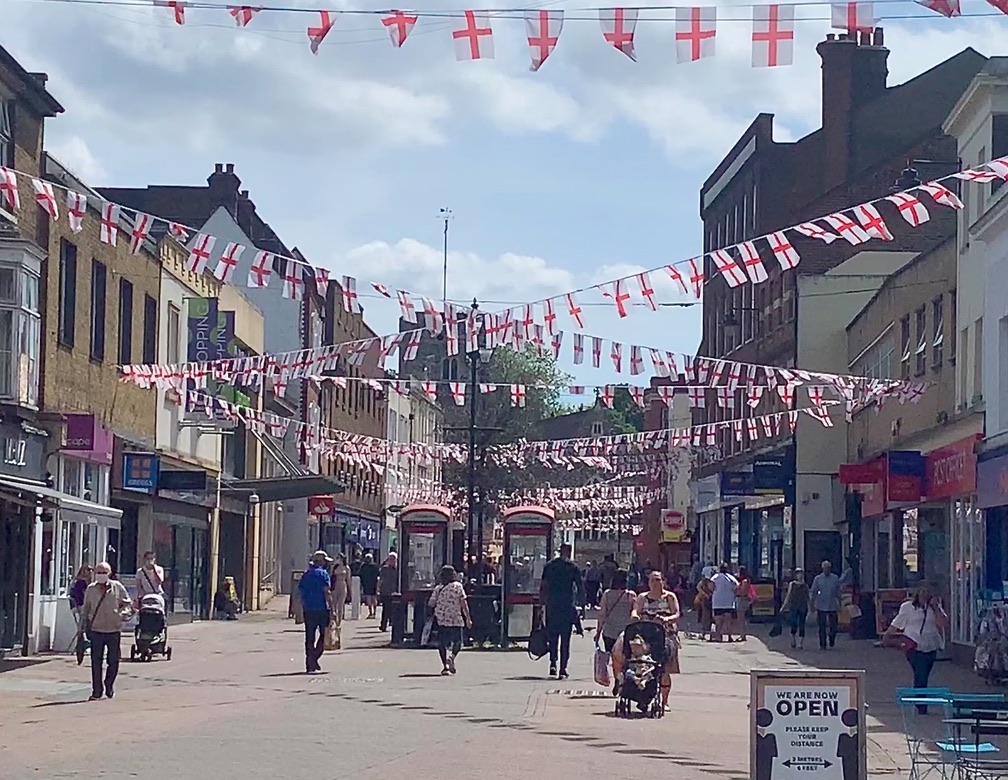
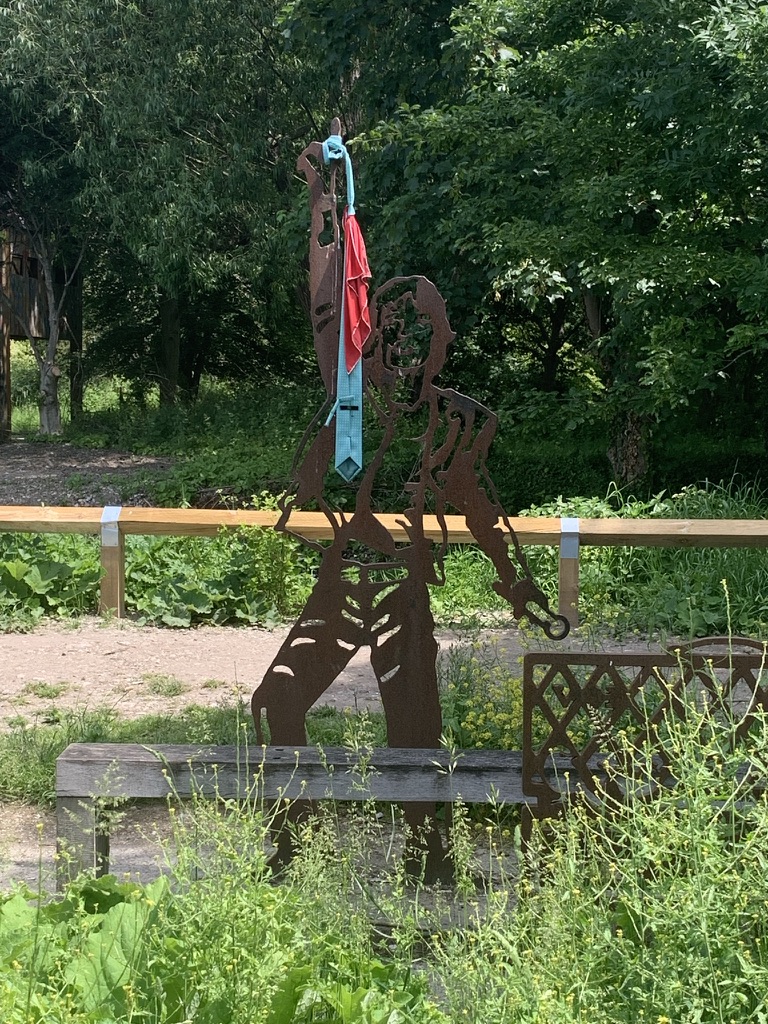
From Dartford the route goes due South and follows the River Darent. Just before the route leaves Dartford, it passes a silhouette of Mick Jagger, one of Dartford’s famous sons. The river valley is very attractive, however in this part of Kent the modern god of the motor car is omnipresent and on this leg our route took us under the M2, the M25 and the M20 before finishing close to the M26. These roads are all extremely busy and generate a constant hum of traffic, which drowns out a lot of the bird song and other wildlife.
As the route moves further away from the River Thames, the conspicuous wealth in the villages becomes more apparent with many large properties complete with multiple motor cars in their driveways. Also there are very few shops or for that matter pubs in many of these commuter villages as they have been turned into homes with the residents shopping in the major shopping centres like Bluewater or increasingly on-line. Supermarket delivery vans are particularly common.
Notwithstanding this, villages like Farningham, Eynsford and Otford are picture postcard pretty, often with a central pond, attractive churches and pubs, many of which have become gastro pubs as they serve their new clientele. Otford in particular has a very pretty pond in its centre complete with 1990s style duck houses.
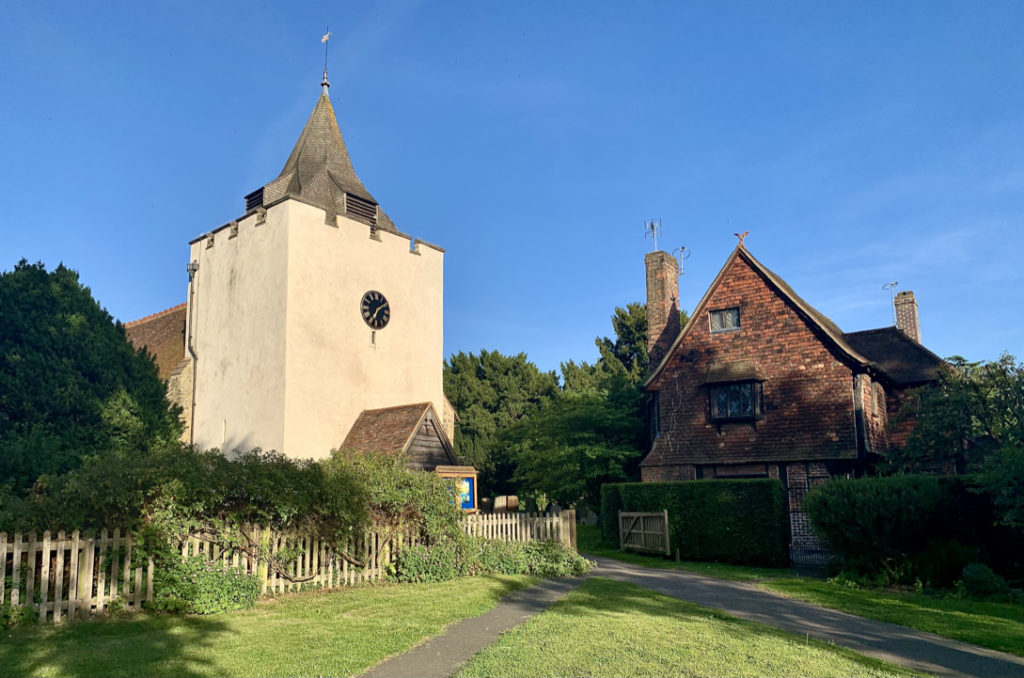
In Kemsing we stayed at Upthedowns B&B a small and very friendly B&B in the middle of a quiet housing estate within easy walk of the pubs and facilities at Otford
Day 3 Kemsing to Wrotham – 11 kms
At Kemsing the Becket route merged with the Winchester route and follows the North Downs Way and / or the Pilgrims Way. The two paths are interchangeable and for the most part are free of traffic, though in parts you do have to make way for local traffic and their delivery vehicles.
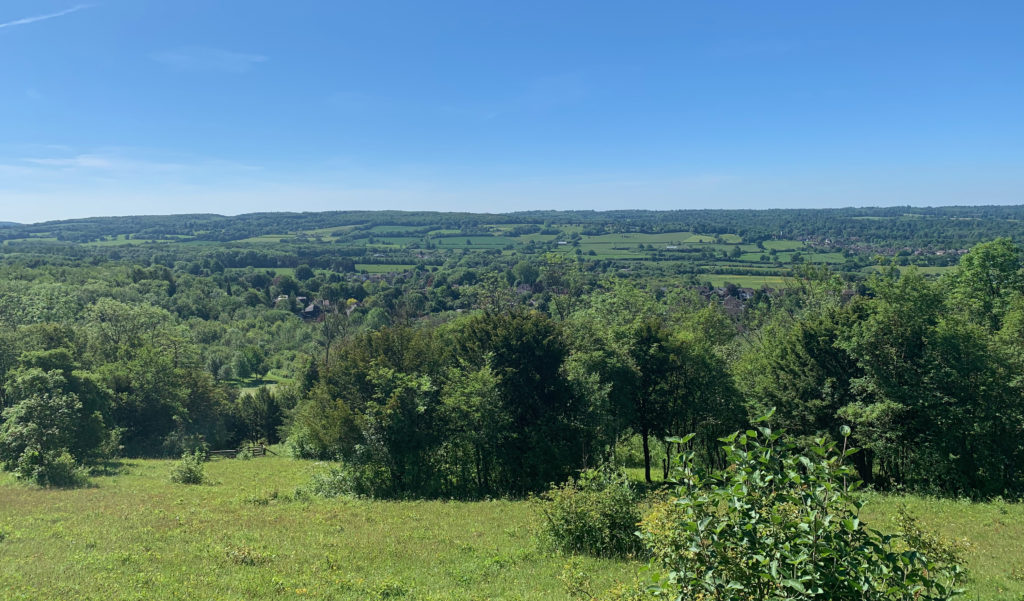
After our ambitious first two days this was a much more modest day’s walk, though it did involve some climbing up and down the North Downs scarp face. On top of the North Downs, the views over Southern Kent were very attractive, and the county in June is particularly green. This part of Kent tends to have arable fields or pasture rather than the more famous fruit orchards and hop fields of Kent. There are a large number of song birds in the hedgerows and deciduous woodlands that the route follows. In the woodlands the route is well covered bay a canopy of old trees, interspersed with open areas affording panoramic views.
Our destination was the attractive village of Wrotham, where we stayed in the traditional Bull Hotel, which is an old pub / hotel, and has become a very pleasant gastro pub serving local ales and good food. The bedrooms in the upper floors have traditional oak beams, wonky floors all in keeping with the rich history of the building. The main bar area of the pub contains a lot of memorabilia to Kent’s role in the Battle of Britain, as the Biggin Hill Airfield is a short distance up the road.
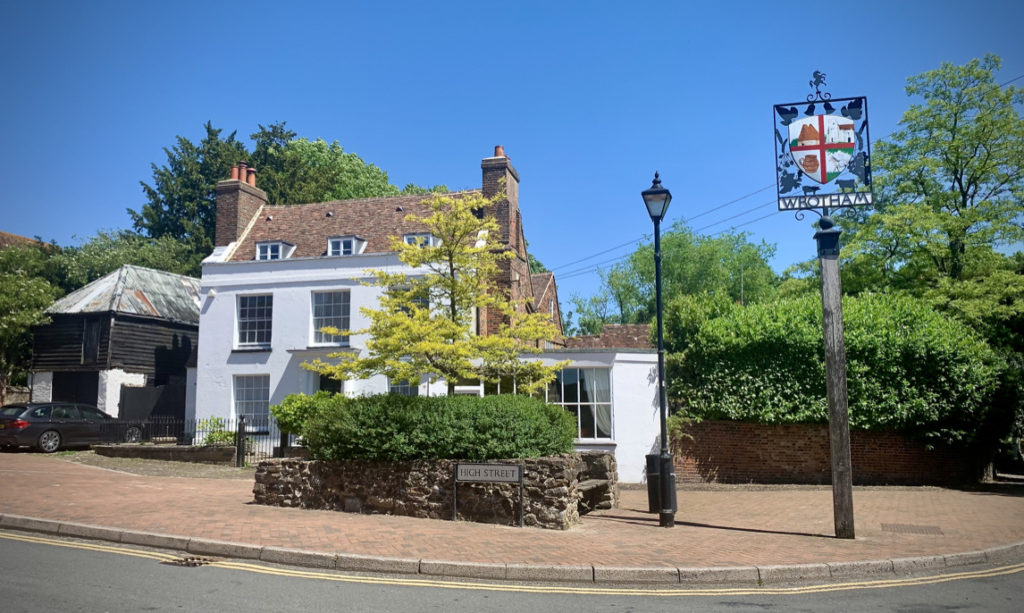
Wrotham has one of the few churches in England dedicated to St George, and the church and its grounds has to be one of the most attractive on our whole pilgrimage, and given the number of pretty churches, that is quite a competitive field.
Day 4 Wrotham to Rochester – 22 Kms
Rochester is a traditional detour on the Pilgrimage Route to Canterbury and while this was a relatively large day, the walk itself was not too difficult and I was able to average over 5 km an hour. The first part of the route followed Pilgrims Way along the base of the North Downs, a largely tree covered route, before climbing the face of the North Downs near Holly Hill.
At Holly Hill there are great views over the Weald Kent and its just about far enough away from the major roads and motorways to be free from the ubiquitous background traffic noise in Kent. The route then takes you into some of the more remote areas of Kent before descending into the Medway Valley at Halling. From Halling the number of properties increases as the route approaches the Medway Towns.

Holly Hill Woods, near Wrotham
Strood, the first town you approach is a semi industrial place with light industry and a number of shops. Just after the main M2 Medway Bridge and HS1 Rail Track is a place for large kids called Diggerland where punters can drive large trucks.
The view across the river to Rochester, with its Norman Castle and its Cathedral dating back to the 600s is well worth stopping for.
In Rochester we stayed in a brand new Travelodge located next to the modern railway station.
Day 5 Rochester – Rest Day
The City of Rochester is a worthy destination in its own right and would make a decent day trip from London on HS1. It is full of history over the past 1,000 years or more but it also is relatively unspoiled by mass tourism.
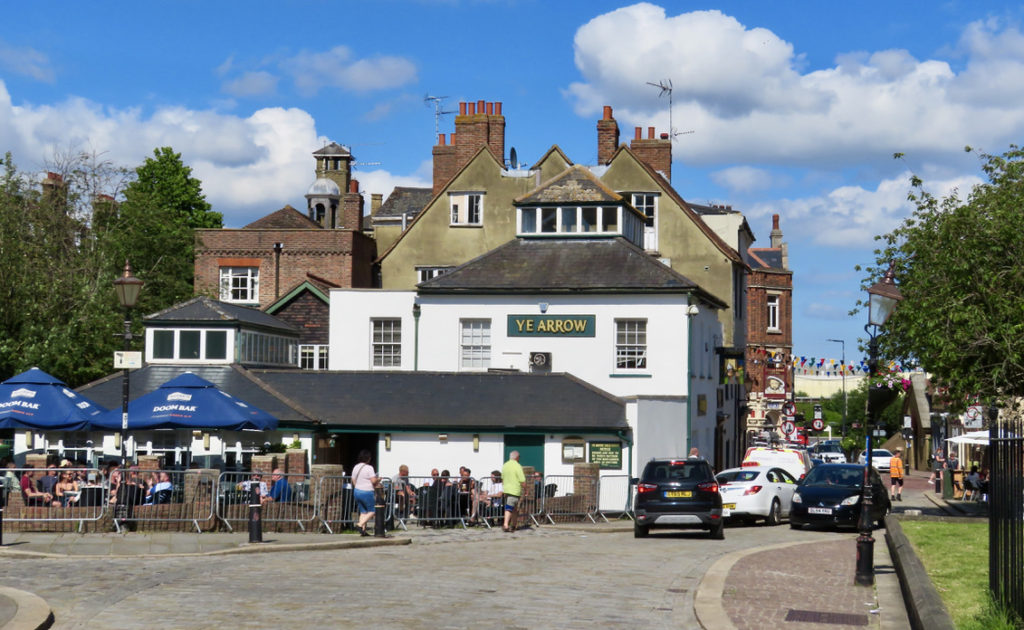
The ruins of the Norman Castle dominates the City’s skyline and is set within pleasant grounds which also act as an important meeting place for local young people. The castle is little more than a shell of its walls as the medieval buildings have long since been lost. The castle played an important part in the rebellions against King John in 1215 and its walls were badly damaged when the King’s forces retook it. Throughout the medieval period the castle which guarded the strategic route from the Channel Ports to London performed and important role in many of the internal conflicts of the time.
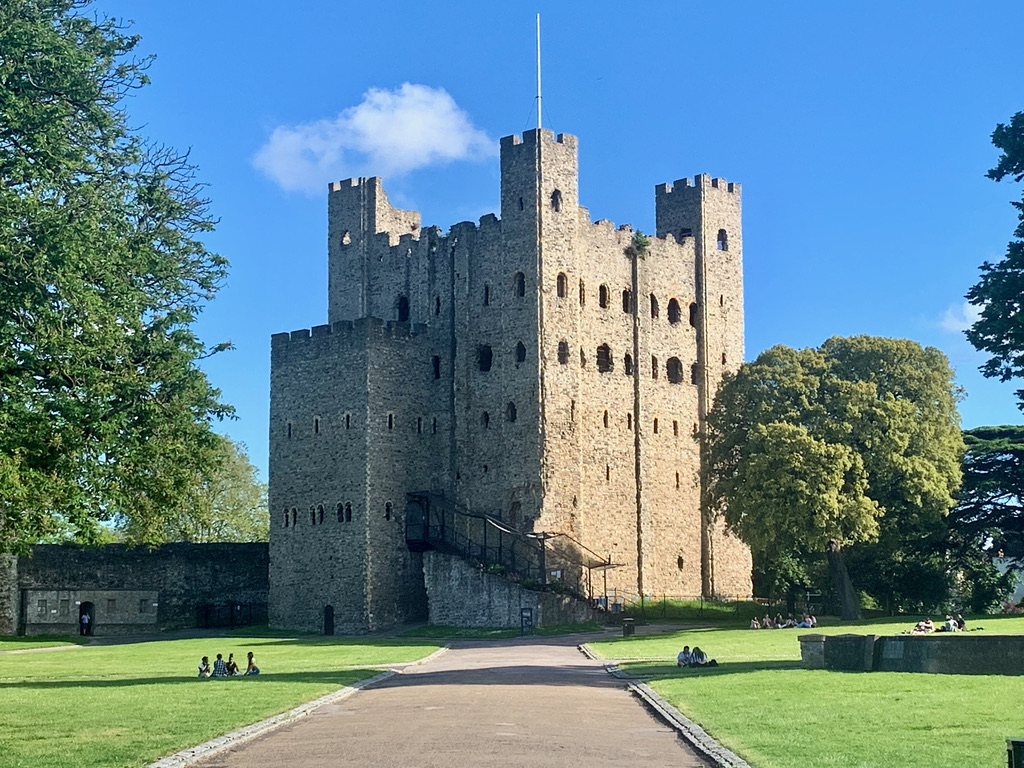
Next to the Castle is Rochester Cathedral, which has also experienced many ups and downs over its life. It dates back to the year 644 and is the second oldest Cathedral in England after Canterbury. In medieval times it was greatly expanded and its interior contained many painted walls. Unfortunately much of its medieval decoration and shrines were destroyed through the vandalism of Henry VIIIs persecution against the Catholic Church. The Cathedral was further seriously damaged during Cromwell’s Civil War in the 1640s as his troops and horses were garrisoned in the Cathedral. More recently through the use of modern infrared photographic technology, archaeologists have been able to get an image of some of the old paintings through the marks ingrained and residual traces of paint in some of the stonework.
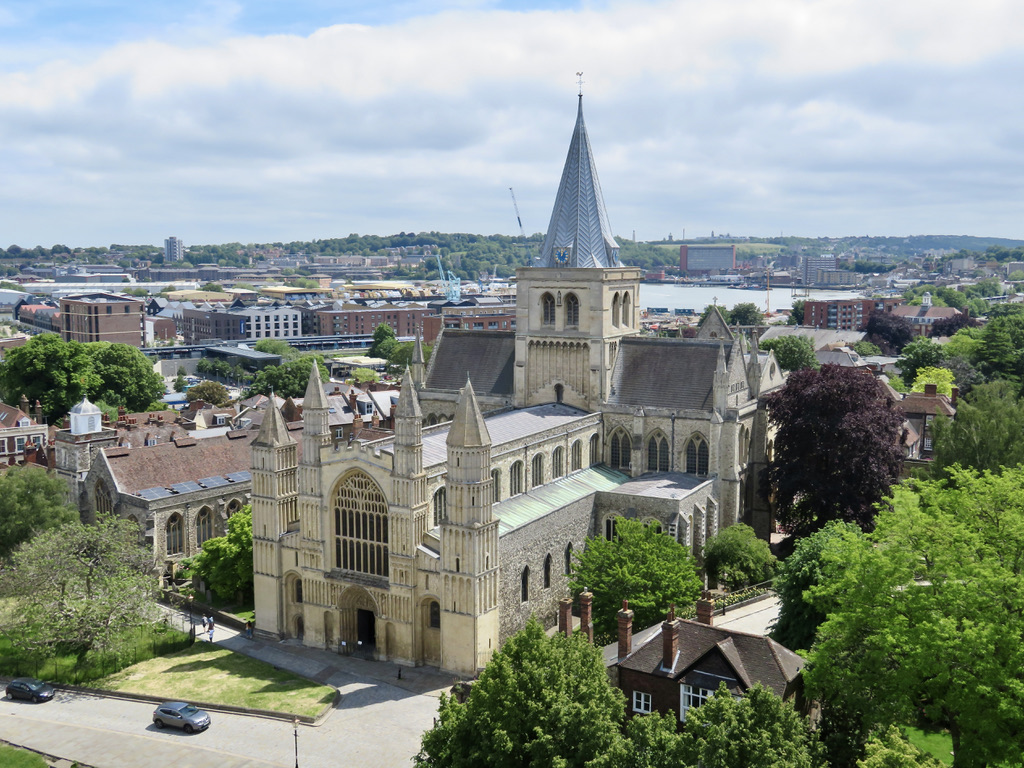
The High Street today is a collection of pubs, hotels and charity shops, as many of the more traditional shops have relocated to Strood or Chatham. One of Rochester’s most famous recent sons was Charles Dickens and the City featured prominently in a number of his major novels. While you won’t meet Miss Havisham, Magwitch or any of his other famous characters, you will find references to many of his characters in the names of the shops, bars etc.
Day 6 Rochester to Sandling via Aylesford Priory – 18 Kms
The route out of Rochester follows the River Medway and on the flood plains of the river there are big open spaces. The vegetation is quite lush and the pathway in places is overgrown by reeds, grasses and also nettles, so the wearing of shorts is not recommended for this leg. However the route is very flat so again it is possible to cover distance quite quickly.
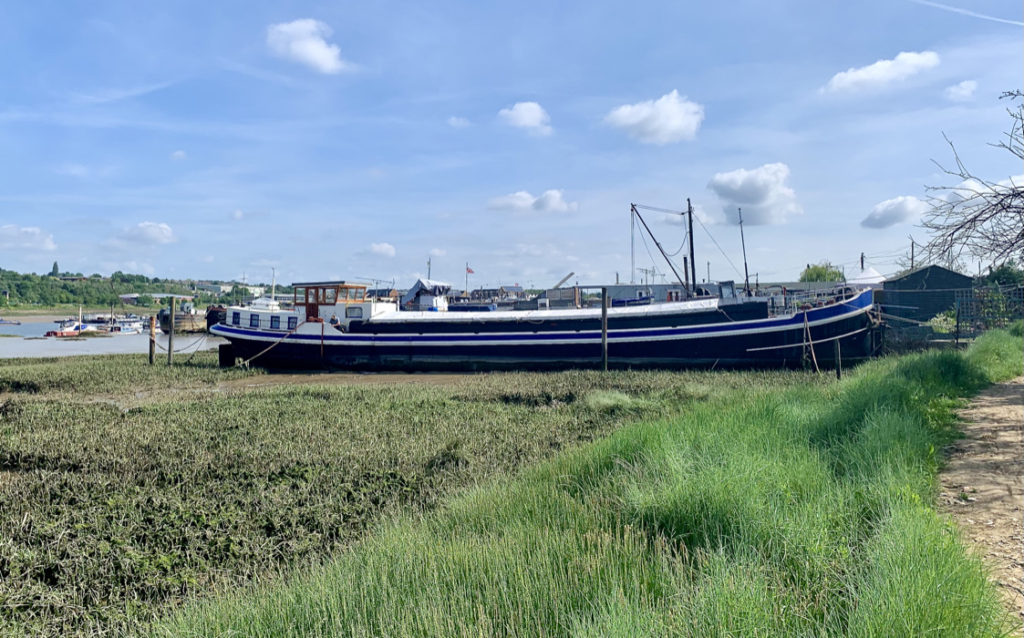
There were a few small villages, like Wouldham, each with an attractive church at its centre, but with very few other facilities or shops, so the car remains king. Further along the route is a large modern housing estate, Peters Village, with its standardised housing stock, and small number of local services.
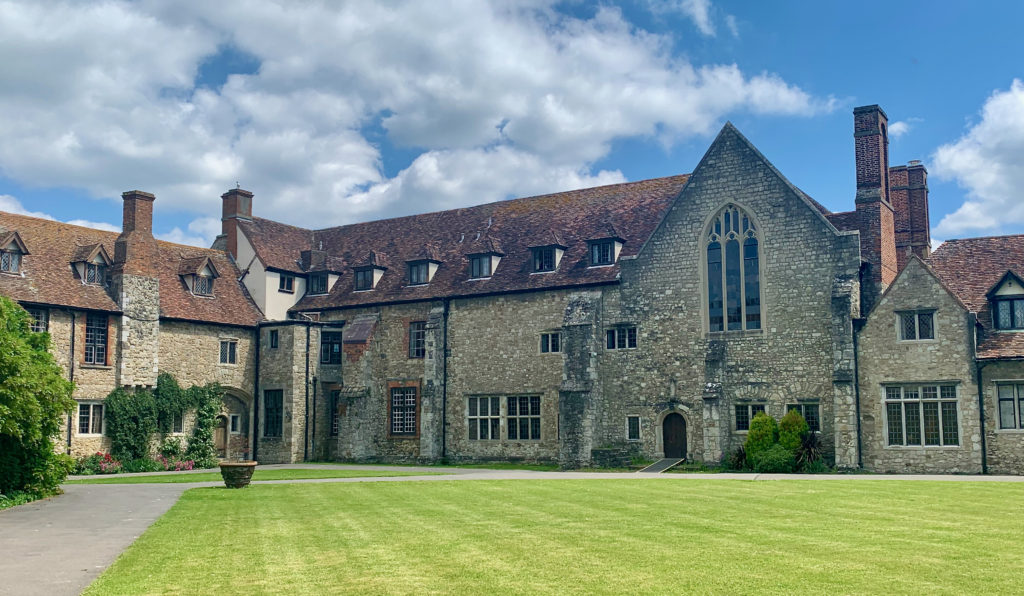
Aylesford Priory is a real oasis of tranquility and as I approached it early on a Saturday afternoon I could hear the music being played during the outside service acting as a beacon to welcome travellers and pilgrims, which is probably how some of the religious places were in the Medieval Times. The Priory has a number of restored buildings and grounds complete with a duck pond and duck houses.
From the Priory the route follows the middle non tidal reaches of the River Medway and passes through the village of Aylesford and the outskirts of Maidstone to Sandling. At Sandling we stayed in the Premier Inn, which sits next to the riverbank and lock where a number of pleasure river craft are moored.
Day 7 Sandling to Lenham – 23 Kms
In Sandling we were joined by our good friend and neighbour Andy for the next couple of legs of our pilgrimage. The walk from Sandling took us back on to The North Downs / Pilgrims Way and followed the North downs eastwards. Also as we moved further away from places that are commutable to London, there was more open spaces and less ribbon development.
The small villages along the route continued to be picture postcard attractive, with central village churches and many well presented and updated villages properties though very few shops. We were walking on a Sunday and when we got to the village of Boxley we saw what looked like a small outside service in the churchyard. When we got to the next village of Detling we were invited into the local church there where there was a small service going on. At the end of the service, the congregation went outside and the organist rigged up a loud speaker system and they all sung the final hymn. Under UK COVID laws, singing hymns at church services is not permitted, so this was a creative way round the rules.

St Martin of Tours Church, Denning
Our route then took us to the slightly larger village of Hollingbourne where we stopped for refreshments in the local pub interestingly called The Dirty Habit. The fields in the surrounding countryside were largely planted with wheat or oil seed rape, which were nearly at full size, and also there were a number of new vineyards with young vines. Climate change meaning that wine is becoming a much more viable crop in Southern England.
From Hollingbourne we headed to our final destination of the day, and probably the most attractive all round village of Lenham, which dates back to Norman times. There we stayed in the Dog and Bear Hotel an old hotel built in 1602 with wooden beams and sloping floorboards. The village of Lenham was probably the best served of all the villages we went to in terms of local facilities and shops.

Lenham
Day 8 Lenham to Chilham – 28 Kms
In Lenham we were joined by two more fellow pilgrims, Jenny & Rob from Oxford so there were five of us on this leg. The route initially took us North out of Lenham and back onto the Pilgrims Way where the first notable landmark was a large chalk cross carved out of the fields on the North Downs slope to commemorate the fallen in World War 1. The farmland continued to be very fertile and some fields unusually had both wheat and barley growing together, can only assume that this is for animal feed.
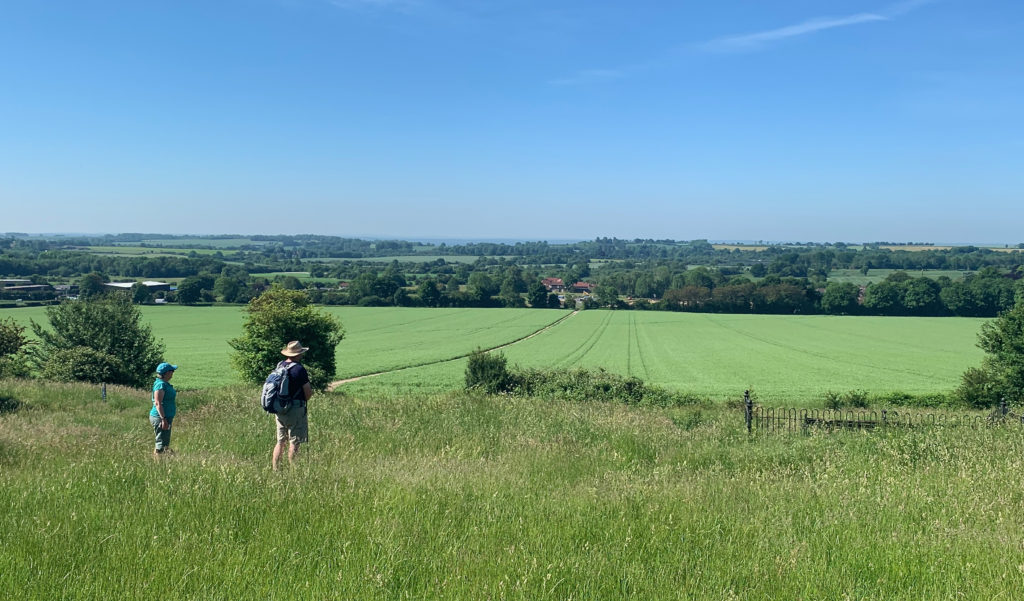
The first major village after Lenham was Charing, again dating back to Norman and earlier times. It was also reasonably well supported with basic shops and facilities and the church yard also contains an Archbishop’s Palace which has history going back to Becket and earlier times.

From Charing the next major settlement was Boughton Lees where we hoped to have lunch in the local pub there overlooking the cricket ground. Unfortunately its was closed so we had little choice but to carry on to our destination of Chilham. The route to Chilham from Boughton Lees includes a steep climb up the North Downs, which after a long day on the road was particularly tiring.
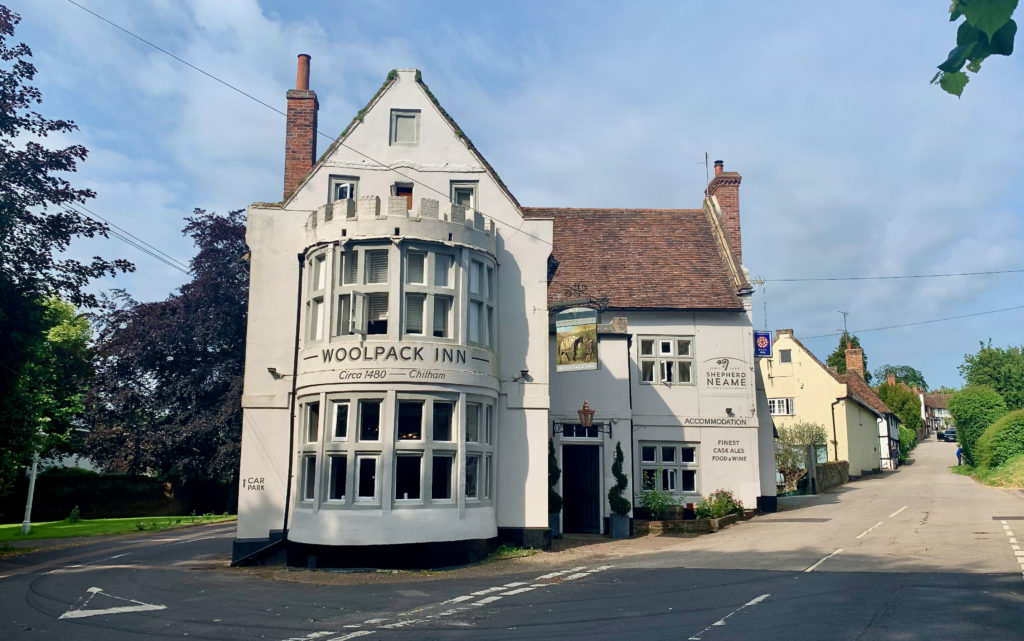
The final route then into Chilham is much easier and the village of Chilham, while having fewer facilities than our more recent destinations was still very pretty. We stayed in the Woolpack Inn, an old pub which has beome quite an upmarket hotel and restaurant. the rooms in the hotel were particularly comfortable.
Day 9 Chilham to Canterbury – 16 Kms
Our final day was much more modest and the walk into Canterbury was relatively easy. The farms in this part of Kent lived up to the more popular image of ket in that there were many more orchards, soft fruit farms and hop fields. Outside the farms much of Pilgrims Way was through deciduous woodlands so the route was fairly sheltered.
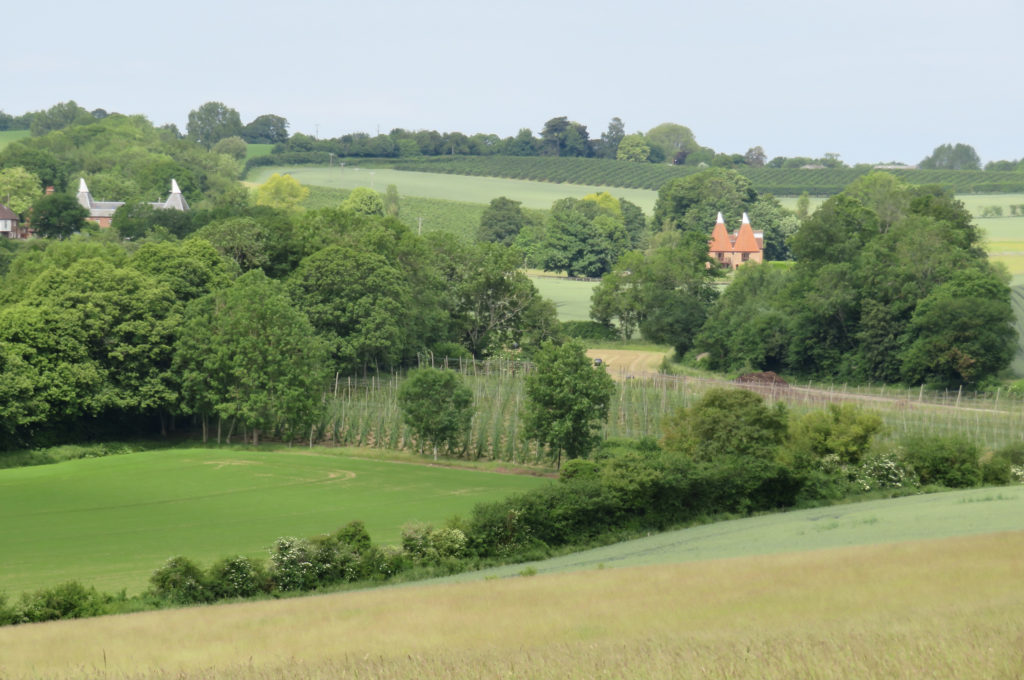
Arriving into Canterbury the route followed the marshlands and flood plains of the Great Stour River. Canterbury is a lively city and quite different from the other large towns we have passed through. In particular with its University it has a lot of young people and also an ethnic mix that is much more similar to what we were used to in London.
The final destination is Canterbury Cathedral, which while its two towers were clad in scaffolding was still an impressive site. Having completed the pilgrimage on foot the staff at the Cathedral welcomed us with open arms and gave us free entry. Inside the Cathedral the local priest was on hand to give us a blessing, which was a fitting conclusion to our journey.
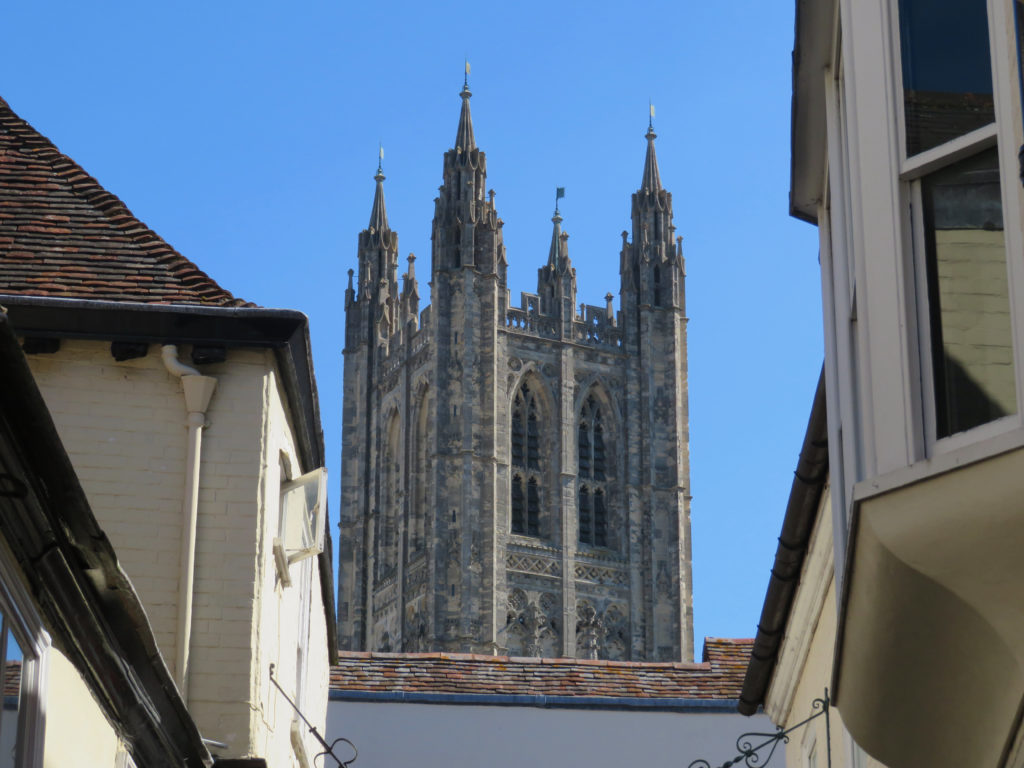
Canterbury Cathedral is full of history and the staff there, many of whom were off duty academics etc. were able to tell many stories of the history and events surrounding the Cathedral. While the story of Becket and his murder by the French, King Henry II’s knights is central to the story of the Cathedral, there were many other interesting stories and facts. Of these some of the ones that captured my imagination were:
– The fact that the Victorians tried to match the colour of some of the stained glass windows to what was there, but then subsequently when the glass was cleaned of pollution the Victorian glass was much darker. They had matched the dirty glass!
– There are two royal tombs, that of the Black Prince and King Henry IV (Bollingbroke) sitting on either side of the main chapel, conveniently forgetting that Henry IV usurped and murdered the Black Prince’s son King Richard II
– The Henry Chichele tomb has been restored in the medieval style and is two tiered with the bottom tier having a simple effigy of a cadaver, below the more ornate funeral effigy.
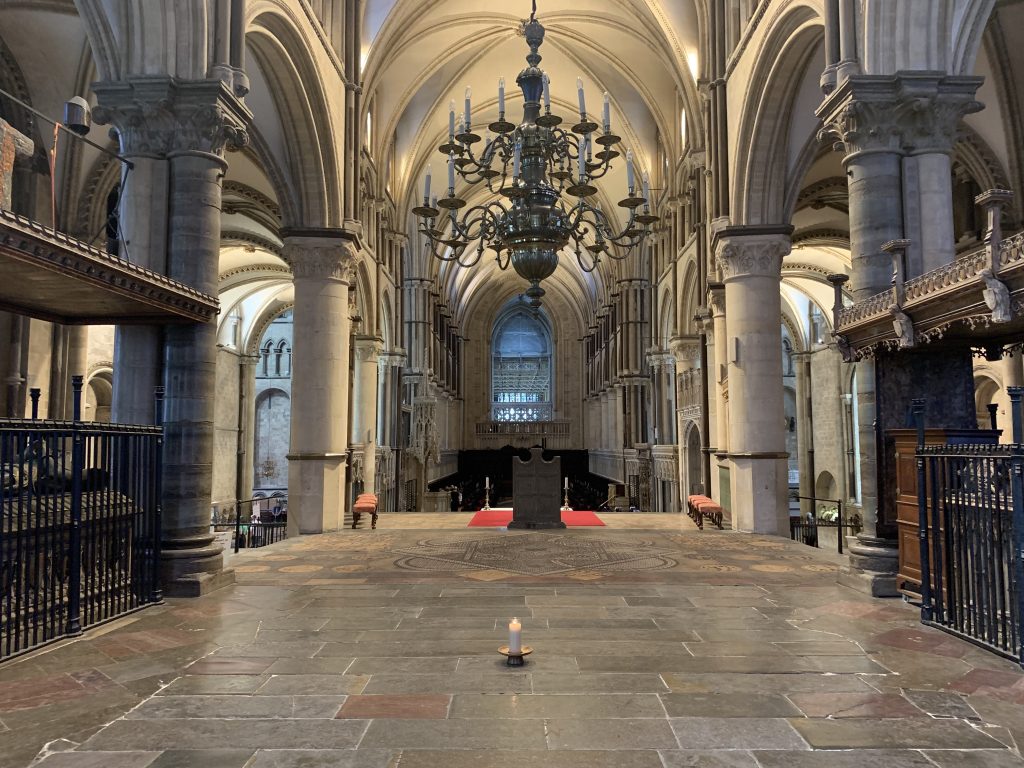
Henry VIII destroyed all evidence of Becket’s shrine as well as many other parts of the Cathedral including the stained glass windows and carvings of saints, but the royal tombs were largely left untouched. Today there are some stained glass windows telling the story of Becket and the miracles associated with him, and also a candle in the middle of the Cathedral. In Henry II’s time after his penance from his role in Becket’s murder, he had to do something about all the pilgrims flocking to the scene of Becket’s murder and was able to generate lots of money from looking after the pilgrims and their donations. This continued right up to Henry VIII’s time
In Canterbury we stayed in a small city centre hotel called Greyfriars Lodge, which was very convenient for all the City’s attractions, though somewhat noisy at night.
Dates: Monday 7th to Thursday 17th June 2021

